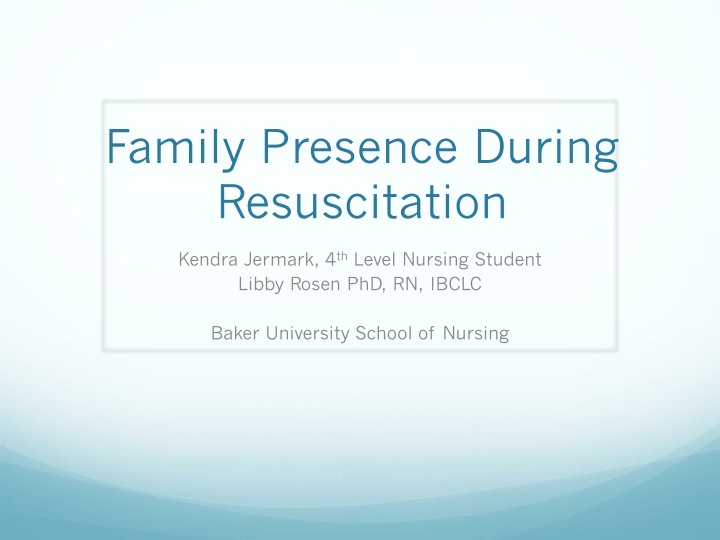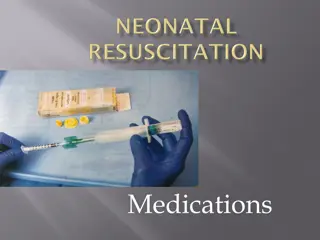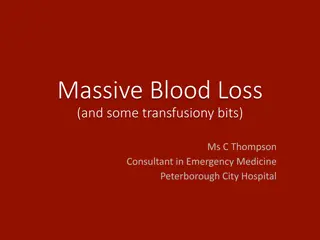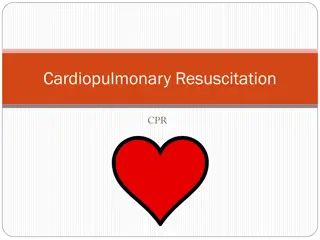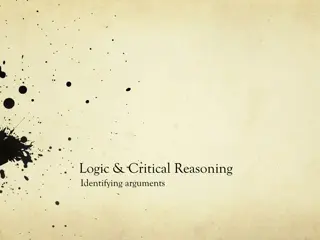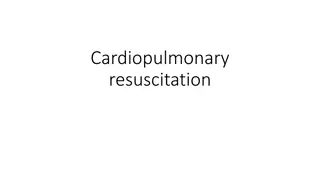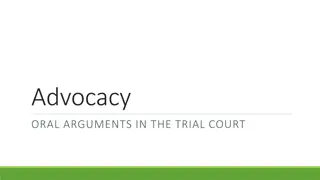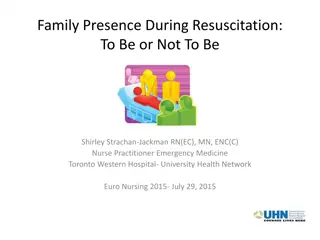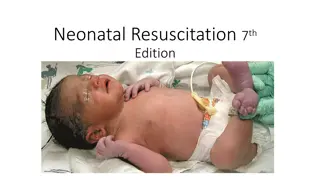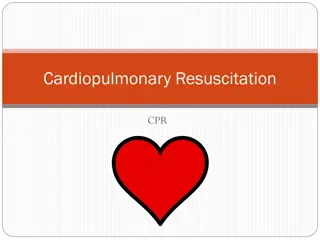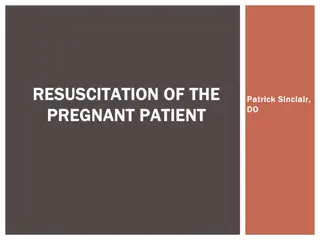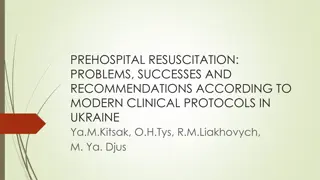Family Presence During Resuscitation: Benefits and Practical Arguments
Family Presence During Resuscitation (FPDR) has numerous benefits including comfort, reassurance, and advocacy for the patient. Studies show that FPDR allows for closure, reassurance to the code team, and advocacy for patient health history. Educating healthcare staff on the advantages of FPDR is crucial to implementation. Lack of policies remains a significant issue, with only a small percentage of emergency departments having specific guidelines in place. Recognizing FPDR as an option and understanding its benefits is essential for patient-centered care.
Download Presentation

Please find below an Image/Link to download the presentation.
The content on the website is provided AS IS for your information and personal use only. It may not be sold, licensed, or shared on other websites without obtaining consent from the author.If you encounter any issues during the download, it is possible that the publisher has removed the file from their server.
You are allowed to download the files provided on this website for personal or commercial use, subject to the condition that they are used lawfully. All files are the property of their respective owners.
The content on the website is provided AS IS for your information and personal use only. It may not be sold, licensed, or shared on other websites without obtaining consent from the author.
E N D
Presentation Transcript
Family Presence During Resuscitation Kendra Jermark, 4thLevel Nursing Student Libby Rosen PhD, RN, IBCLC Baker University School of Nursing
Introduction Family Presence During Resuscitation FPDR Benefits outweigh the negative effects Evidence based practice studies have proven benefits Patient, Family & Healthcare team Ethically it s the patient s choice Advocate, Nonjudgmental, Implement wishes Lack of policies is an issue Educate healthcare staff on benefits
Background The Institute of Medicine stated in 2001 Healthcare needs to be more family centered FPDR is an example (Ganz & Yoffe, 2012) 600,000 cardiac deaths per year (Jabre, Belpomme, Azoulay, Jacob, Bertrand, Lapostolle, & Turi, 2013) Important to recognize FPDR as an option Know FPDR benefits Estimated only 5% of EDs have policies about FPDR (Hardin-Fanning & Yoder, 2014)
Practical Arguments for the Benefits of Family Presence During Resuscitation Benefits Comfort Reassurance Advocating for the patient Awareness of situation Helping with grief
Comfort FPDR allows for closure (Leske, McAndrew, & Brasel, 2013, p. 78) Feelings of comfort and opportunity for goodbyes Expressed by families Unconscious patients can hear One patient heard his wife s voice and this encouraged him to fight for survival (Doolin, Quinn, Bryant, Lyons, & Kleinpell, 2011, p. 11)
Reassurance View the code team work Reassurance that everything possible was done (Parial, Torres, & Macindo, 2016) Study on how physicians and nurses view FPDR Witnessing family could see that everything was done (Sak-Dankosky et al, 2013) Evaluations of witnessing family Comforting to see the team work All hands on deck approach (Leske et al., 2013, p. 80)
Advocating for the Patient Family felt reassured to advocate Health history Current medications Allergies (Leske et al., 2013) FPDR provided frequent updates Present family can update not present members Healthcare team can update family (Leske et al., 2013)
Understanding the Situation FPDR helps the family comprehend (Doolin et al., 2011) Pediatric Intensive Care Unit FPDR analysis Present parents could advocate and make decisions regarding cessation of CPR (Smith & Carew-Lyons, 2014)
Helping with Grief FPDR help start grieving process (Dwyer & Friel, 2016) FPDR allowed family to be present in the patient s last moments (Itzhaki, Bar-Tal, & Barnoy, 2012) 570 Participants Control group did not experience CPR FPDR group 90 days later Control group showed higher symptoms PTSD, depression, and anxiety (Jabre, Belpomme, Azoulay, Jacob, Bertrand, Lapostolle, & Turi, 2013)
Ethical Frameworks and Ethical Values Deontological Ethical Theory AKA Kantianism People should be treated as an end and not a means to an end Patient should be viewed as a whole FPDR is a holistic approach Freedom of decision (Burkhardt & Nathaniel, 2014) Autonomy Ethical Principle Self governing Easily violated (Burkhardt & Nathaniel, 2014) Paternalism Ethical Principle Acting in a fatherly manner (Burkhardt & Nathaniel, 2014)
Possible Objections to the Policy Pressure on staff Distractions Psychological and emotional trauma Increased Lawsuits Breaching Confidentiality
Increased Pressure on Staff Medical Residents Perceptions on FPDR Fear of looking inexperienced (Carroll, 2014) Results FPDR did not inhibit decision making abilities Promoted teamwork (Doolin et al., 2011) Communication was not affected (Leske, McAndrew, & Brasel, 2013)
Increased Distractions Fear of family losing control and increasing distractions (Clark et al., 2013) Analysis Observed present family Conclusion No questions asked or distractions (Dwyer & Friel, 2016) Examined witness aggression 570 participants 1% displayed aggression (Jabre et al., 2013) Providers responses Tolerated event well Did not inhibit efforts (Leske et al., 2013) Family responses Did not want to distract staff away from loved one (Leske et al., 2013)
Psychological and Emotional Trauma Fear the witnesses will experience physiological and emotional trauma (Clark et al., 2013) Study on FPDR and trauma Control group not experience FPDR Group who did experience FPDR Control group had more symptoms PTSD, anxiety, and depression (Jabre et al., 2013) FPDR in an unsuccessful resuscitation Helped to begin grief (Itzhaki et al., 2012)
Increased Lawsuits Fear of increased patient care lawsuits (Clark et al., 2013) Study on 570 participants After 2 years of applying FPDR No legal claims (Jabre et al., 2013) Witnesses view the exhaustive process (Parial et al., 2016) Families responded Appreciation for the code team (Leske et al., 2013)
Breaching Patient Confidentiality Fear of breaching patient confidentiality (Itzhaki et al., 2012) Study opposed this fear Considerate Respected patient s privacy (Doolin et al., 2011)
Facilitating Change Create policies on FPDR Increase research on FPDR Educate healthcare staff
Policy Suggestions Receive information about FPDR on admission (Doolin et al., 2011) Trained family support facilitator Remain with family Healthcare staff, social worker, or Chaplin Prepare family (Doolin et al., 2011) Limit participation (Doolin et al., 2011) Lack of space Increased equipment and staff Bigger critical care rooms (Leung & Chow, 2012)
Increasing Research FPDR is under researched Difficult topic (Parial at al., 2016) New findings Create policies Keep up to date (Parial at al., 2016)
Education Lack of acceptance of FPDR Due to no education on benefits Increasing staff education May increase implementation of FPDR (Hardin-Fanning & Yoder, 2014)
Nursing Implications Nurses need to Be aware Provide guidance Educate Facility and national guidelines Know personal opinions Respect the patient s autonomy Assess choices Implement the decision about FPDR
Summation and Conclusion Benefits Comfort Advocate Understand situation Reassurance Helping grief o Every healthcare setting o FPDR policies o Establish and implement o Educate staff o FPDR benefits Concerns Increased stress Distractions Witness trauma Legal issues Breaches of confidentiality
Carroll, D. L. (2014). The effect of intensive care unit environments on nurse perceptions of family presence during resuscitation and invasive procedures. Dimensions Of Critical Care Nursing, 33(1), 34-39. doi:10.1097/DCC.0000000000000010 Clark, A. P ., Guzzetta, C. E., & O'Connell, K. J. (2013). Family presence during resuscitation attempts is associated with positive psychological effects for the observers. Evidence Based Mental Health, 16(3), 78-78. doi:10.1136/eb-2013-101354 References Doolin, C., Quinn, L., Bryant, L., Lyons, A., & Kleinpell, R. (2011). Family presence during cardiopulmonary resuscitation: Using evidence-based knowledge to guide the advanced practice nurse in developing formal policy and practice guidelines. Journal Of The American Academy Of Nurse Practitioners, 23(1), 8-14. doi:10.1111/j.1745- 7599.2010.00569.x Dwyer, T., & Friel, D. (2016). Inviting family to be present during cardiopulmonary resuscitation: Impact of education. Nurse Education In Practice, 16(1), 274-279. doi:10.1016/j.nepr.2015.10.005 Ganz, F . D., & Yoffe, F . (2012). Intensive care nurses' perspectives of family-centered care and their attitudes toward family presence during resuscitation. Journal Of Cardiovascular Nursing, 27(3), 220-227. Hardin-Fanning, F ., & Yoder, E. (2014). Family presence during CPR: The impact on emergency room staff. Kentucky Nurse, 62(4), 4-5. Itzhaki, M., Bar-Tal, Y ., & Barnoy, S. (2012). Reactions of staff members and lay people to family presence during resuscitation: the effect of visible bleeding, resuscitation outcome and gender. Journal Of Advanced Nursing, 68(9), 1967-1977. doi:10.1111/j.1365-2648.2011.05883.x Jabre, P ., Belpomme, V., Azoulay, E., Jacob, L., Bertrand, L., Lapostolle, F ., & ... Turi, L.
